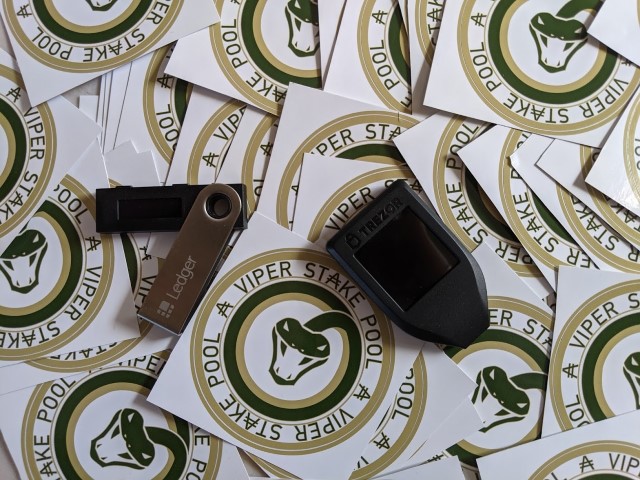What is a hardware wallet?
Cryptocurrency hardware wallets protect your funds by enforcing two-factor authentication (“something only you have and something only you know”). When using a regular software wallet, you authenticate a transaction with a spending password that you choose. If that password is leaked, or an adversary gains access to your computer, an adversary can steal your funds. With a hardware wallet, you must authorize every transaction by entering a PIN on a physical device connected to your computer or mobile device. There is no risk of an adversary remotely gaining access to your funds in this situation.

Why should I use one?
All blockchain transactions are governed by public and private key pairs. A user is authorized to make a transaction by proving they have access to a wallet’s private key. If someone else gains access to this key, they can authenticate this wallet’s transactions and access its funds. A hardware wallet holds the private keys to your cryptocurrency wallets, and these keys never leave your device, keeping them safe from adversaries. When setting up the device, you will write down a recovery phrase that you can use to recover your wallets to another hardware device if your hardware wallet is lost or destroyed. You must never store this phrase on a device connected to the Internet. If this phrase is leaked, someone else can use it to recover your wallets to a new device and steal your funds.
Even if someone gains physical access to your hardware wallet, they cannot access your funds without knowing your PIN. If the wrong pin is input too many times, the hardware wallet will erase itself and will need to be recovered using the recovery phrase.
To provide additional security, some hardware wallets support hidden wallets by pairing your PIN with any number of different passwords/passphrases (not to be confused with the recovery phrase used to restore your hardware wallet). Each unique PIN + passphrase combination accesses an entirely different wallet, and without knowing these, there is no way to know that this wallet even exists. This feature provides plausible deniability as well as increased security. For example, if you are in a situation where an adversary coerces you to unlock your device, or if someone gains access to your recovery phrase, it is impossible to access the funds on your hidden wallets without also knowing the passphrase. One could even set up a “decoy wallet” with a small amount of funds on it, which you could give up if threatened without revealing the existence of hidden wallet(s) that hold the majority of one’s crypto funds.
Which hardware wallet should I use?
When choosing a hardware wallet, you must first verify the device in question supports the cryptocurrencies you plan to store on it. Cardano is currently fully supported by the Trezor Model T and the Ledger Nano (S and X versions). Below we will compare these devices’ features to help you make an informed decision on which wallet is best for you.
Price
- Ledger Nano S: $59
- Ledger Nano X: $119
- Trezor Model T: $192
Winner: Ledger Nano S
App Limit
To use a cryptocurrency with a Ledger device, you must install the associated application on the device itself. These devices are limited by their onboard storage, and the number of apps they can hold varies significantly based on the particular currencies you intend to use. The Nano S can hold 3 to 20 apps, while the Nano X can hold up to 100 apps. The Trezor Model T, on the other hand, has no such limit.
Winner: Trezor Model T
Touchscreen vs Buttons
A device with a touchscreen is substantially more straightforward to use than one without. Typing in a PIN by scrolling through digits using only one or two buttons (e.g., the Ledger Nano) can be tedious. In addition to ease of use, a device with a touchscreen (e.g., Trezor Model T) can provide better security by never having to type in hidden wallet passphrases via the computer with which it interfaces. While you are provided the option to type in your passphrase on your computer to unlock the hardware device, we recommend you always input the passphrase directly on the device. An adversary could potentially access your hidden wallet passphrase through malware on your computer (e.g., a keylogger). This is not possible if you enter the passphrase directly on the device.
Winner: Trezor Model T
Screen Size
A small screen makes it difficult to read data displayed on the hardware wallet (e.g., confirming a transaction before authorizing it). Devices with larger screens can present the information in a format that is much easier to digest, and users are thus less likely to make a mistake.
- Ledger Nano S: 128 x 32 pixels
- Ledger Nano X: 128 x 64 pixels
- Trezor Model T: 240 x 240 pixels
Winner: Trezor Model T
Host Compatibility
While all three devices support Windows, Mac, and Linux PC connections, Ledger devices can additionally be used with mobile devices. The Ledger Nano X supports iOS and Android, while the Nano S only supports Android.
Winner: Ledger Nano X
Wireless Capability
The Ledger Nano X is the only hardware wallet that supports wireless connection to the host device (i.e., Bluetooth). The Nano S and Trezor Model T require a USB connection.
Winner: Ledger Nano X
Hidden Wallet Support
While all three devices support hidden wallets using passphrases, the Trezor Model T’s touchscreen makes this significantly more manageable and user-friendly.
Winner: Trezor Model T
Summary
Overall, we recommend the Trezor Model T. Its increased capability over the Ledger Nano devices more than makes up for the higher price. However, using any hardware wallet is much more secure than not using one at all. We suggest that if your cryptocurrency holdings are worth at least ten times more than the cost of a hardware wallet, it is time to invest in one.
If you would like to support our pool and the content we provide, please consider using the affiliate links above when purchasing a hardware device.
Once you’re ready to stake your ADA, check out our tutorials for staking using the Daedalus or Yoroi wallets. If you have questions about hardware wallets or anything else related to Cardano, feel free to join our Telegram channel. Follow us on Twitter and Reddit to be notified of future posts!


